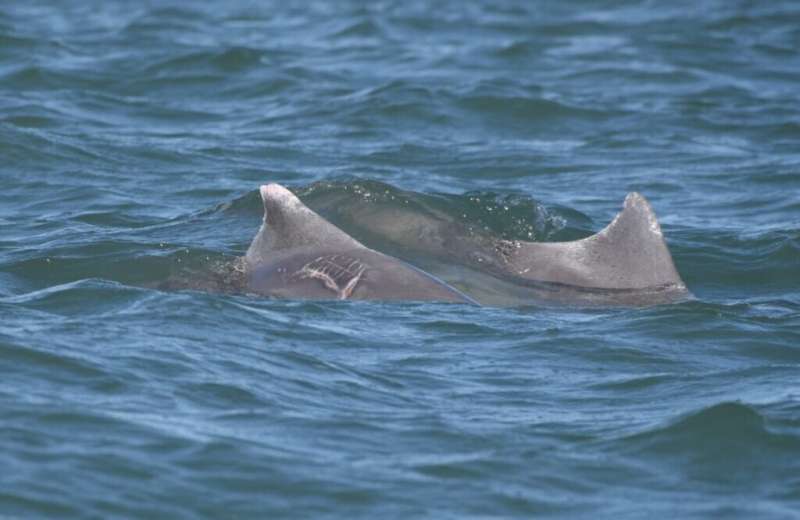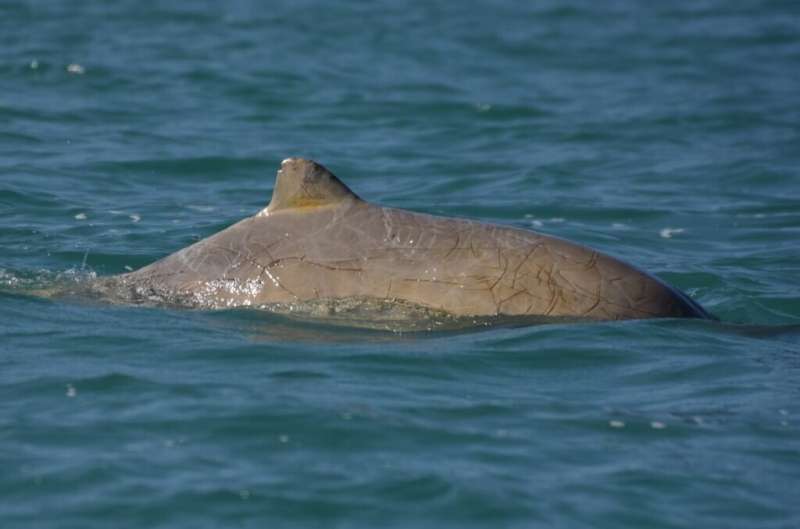This article has been reviewed according to Science X's editorial process and policies. Editors have highlighted the following attributes while ensuring the content's credibility:
fact-checked
peer-reviewed publication
trusted source
proofread
Photographic study reveals incidence of attempted shark predation on Australian dolphins

Dolphins and porpoises are welcome features of Australia's coastline however little is known about the predation risk they face from sharks in their habitat.
In one of the first studies of its kind in Queensland, marine mammal experts from Flinders University and around Australia found about one-quarter of Australian snubfin and humpback dolphins studied near Gladstone, Bowen and Townsville featured shark-inflicted wounds.
This study provides a baseline to monitor the effects of predation pressure on habitat use, behavior and group living of these dolphin species living among bull, tiger and white sharks in coastal waters of south, central and north Queensland, says Caitlin Nicholls, from the Cetacean Ecology, Behavior and Evolution Lab (CEBEL) at Flinders University.
The study assessed thousands of photos taken from boat-based surveys, with 33% of the 56 snubfin and 24% of 36 humpback dolphins identified and with greater photographic coverage of their dorsal bodies showing evidence of shark bites to gain new insights into failed predation attempts rather than fatality rates. The paper is published in the journal Ecology and Evolution.
"Overall, the study also found increased predation pressure on dolphins in northern Queensland, increased predation pressure closer to the coast and equal predation pressure between the two species," says Nicholls.
"This study is the first to assess the occurrence of shark-bite scarring on snubfin and humpback dolphins in Queensland across different group sizes, habitat features, and locations, and serves as a baseline for shark-dolphin interactions in the area.

"These results highlight the importance that habitat features could have in predation pressure of dolphins, as well as the importance of considering photographic coverage when assessing bite injuries on animals."
The research by CEBEL on Australian snubfin and humpback dolphins, led by Flinders University researcher Associate Professor Guido J Parra, is focused on monitoring both species which are listed as Vulnerable by the Queensland Nature Conservation Act and by the IUCN Red List of threatened species.
The presence of shark-inflicted wounds and scars on live individuals can provide an indirect measure of predation pressure, representing failed predation attempts, and provide an estimate of the frequency of shark attacks, says Associate Professor Parra.
"Predation and predation risk have a large influence on the ecology and evolution of both predator and prey species; therefore, to decipher how communities are structured and function, we need to understand how predators and prey interact," he says.
Snubfin and humpback dolphins in northern Australia are characterized by small population sizes, low genetic diversity and slow reproduction. Their ability to avoid predation from sharks is aided by altering their decisions regarding food, mates, groupings and habitat.
More information: Caitlin R. Nicholls et al, Incidence of shark‐inflicted bite injuries on Australian snubfin ( Orcaella heinsohni ) and Australian humpback ( Sousa sahulensis ) dolphins in coastal waters off east Queensland, Australia, Ecology and Evolution (2023). DOI: 10.1002/ece3.10026
Journal information: Ecology and Evolution
Provided by Flinders University



















